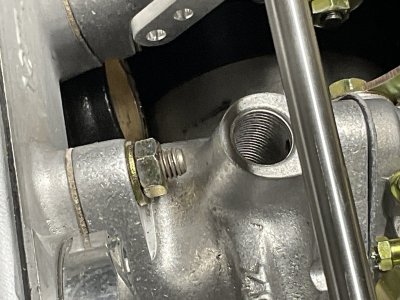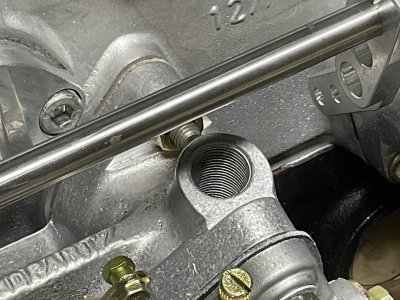How do you know the air is coming from the MC?
I also used a similar pressure bleeder on my car filling a completly empty system a few weeks ago.
If you open the bleed nipples too much when you use a vacuum bleeder, air can be sucked in through the nipple threads and creating bubbles.
I think the same applies when using a pressure bleeder.
Could this be happening?
Some people recomend using grease on the threads to seal it up some.
Does the brake pedal feel spongy?
My procedure was like this on an all empty system. New lines, and all new parts exept rear calipers that were rebuildt.
- Hooked up the pressure bleeder, with no brake fluid yet, and did a pressure test on the empty system by pumping up to 10-15psi.
(My pressure bleeder has an adapter cap that screws directly to the reservoir)
- Checked/listened for leeks.
- Then opened all bleed nipples one by one to check that air was coming through.
- Disconnected the pressure bleeder.
- Filled up the brake reservoir with fluid.
- Started with the bleed nipple farthest away, opened it up and used a manually operated vacuum pump to get fluid flowing through.
Didnt care so much about air bubbles at this time. Worked my way in the right sequence with the rest of the lines including the clutch system. Same time keeping an eye on the reservoir level.
- Hooked up the pressure bleeder again. Filled it up with 1L of fluid. Pumped it up to 10psi and started bleeding in the right sequence.
Used a catch can with no non-return valve.
- Disconnected the pressure bleeder.
- Pumped the brake pedal a couple of times.
- Topped up the reservoir.
- Started the engine and checked the function of the brake booster.
I must mention that this was my first time filling an empty system and my first time with the pressure bleeder.
Others may have procedures that works good as well.
I also used a similar pressure bleeder on my car filling a completly empty system a few weeks ago.
If you open the bleed nipples too much when you use a vacuum bleeder, air can be sucked in through the nipple threads and creating bubbles.
I think the same applies when using a pressure bleeder.
Could this be happening?
Some people recomend using grease on the threads to seal it up some.
Does the brake pedal feel spongy?
My procedure was like this on an all empty system. New lines, and all new parts exept rear calipers that were rebuildt.
- Hooked up the pressure bleeder, with no brake fluid yet, and did a pressure test on the empty system by pumping up to 10-15psi.
(My pressure bleeder has an adapter cap that screws directly to the reservoir)
- Checked/listened for leeks.
- Then opened all bleed nipples one by one to check that air was coming through.
- Disconnected the pressure bleeder.
- Filled up the brake reservoir with fluid.
- Started with the bleed nipple farthest away, opened it up and used a manually operated vacuum pump to get fluid flowing through.
Didnt care so much about air bubbles at this time. Worked my way in the right sequence with the rest of the lines including the clutch system. Same time keeping an eye on the reservoir level.
- Hooked up the pressure bleeder again. Filled it up with 1L of fluid. Pumped it up to 10psi and started bleeding in the right sequence.
Used a catch can with no non-return valve.
- Disconnected the pressure bleeder.
- Pumped the brake pedal a couple of times.
- Topped up the reservoir.
- Started the engine and checked the function of the brake booster.
I must mention that this was my first time filling an empty system and my first time with the pressure bleeder.
Others may have procedures that works good as well.



